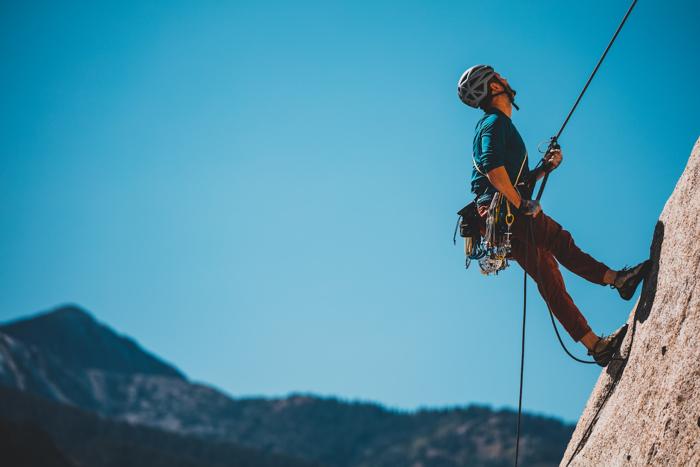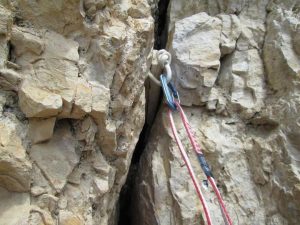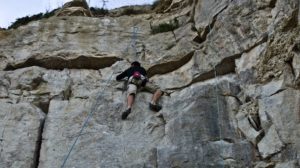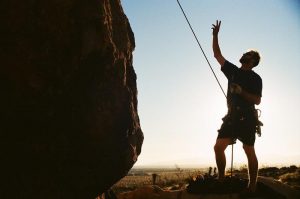Climbing pertains to an upward movement, ascending a steep surface. Nowadays, the term is becoming more popular— a challenging recreational activity.
Many people are fascinated with this activity as it challenges the mind and body. Climbing involves several sub-disciplines, techniques, settings, eqsuipment, and different difficulty levels due to a broad spectrum of natural formations worldwide.
As someone new to rock climbing, it is always wise to be equipped with the proper knowledge and techniques, for there are many aspects of this activity that can be considered risky and extreme.
But before we delve deeper into the marvellous world of climbing, let’s get acquainted with its various types. Here are the most popular ones:
Top Roping
The climbing rope has already been set up in top-roping — the rope threads through an anchor placed at the top of the climbing wall. One end of the rope is connected to the climber while the belayer holds on to the other end. It’s the belayer’s job to take up the slack as the climber ascends the route.
Real top-roping requires the belayer at the top of the climbing wall to control the rope as the climber ascends. However, the widespread practice involves belayers situated on the ground level, with the anchor serving as a tool to make their assistance more effective. Because of this setup, the practice is also known as BOTTOM-ROPING.
Getting Started
Before starting with the outdoors, you will likely have to spend time training in a gym to hone your skills.
Climbing is both a physical and mental activity that demands a lot of practice, technical knowledge, and patience. Practicing in a climbing gym is a superb way to improve these traits. Many gyms offer certified instruction on gear, leading, and shifting to outdoor climbing.
If your target is outdoor top-roping, the most sensible step to take is bouldering. It is the quickest method to grasp what rock climbing is. Besides, bouldering is an efficient method to build climbing strength without the pressure of commitment. It is the best introduction for any rock-climbing neophyte.
Once your climbing strength is sufficient, you can start learning the basic top-roping— tying yourself in to climb and top-rope belay. And for this, you will have to attend a belay class.
Outdoor Top Rope Climbing
Although the setting differs, you will use the same kind of gear in both indoor and outdoor top-rope climbing. However, top outdoor roping is riskier simply because you have less control over the environment. But then again, the changes in scenery, terrain, and weather are all elements that add to the fun factor of outdoor top-rope climbing.
There are two ways to set up top-rope climbing in an outdoor environment. First, the climber has to hike up to the top of the wall and perform one of these three methods:
- Anchor the rope to a large, sturdy tree.
- Construct the traditional anchor to run the rope through.
- Thread the rope through a pre-established bolted anchor.
Second, they have to allow a lead climber to ascend the rough and set up a bolted or traditional anchor.
Once the rope is secured through an anchor, you can hike back to the bottom and commence top-roping the route. If you let a lead climber do the setup, you must follow them up on top rope after they go back to the ground. If the route is overhanging or deviates, make sure to climb on the end of the rope nearest to the wall.
To be on the safe side— if you’re not yet confident about properly setting up an outdoor top-rope anchor, don’t hesitate to ask someone to do it for you. Even if it’s an easy skill to learn, the slightest mistake can cause severe injuries.
Reasons to Try Top Rope Climbing
Top roping may not be devised to get you to the highest mountain peak. However, it guarantees fun and enjoyment with your friends.
Top Roping is Less Risky
Injuries happen in any climbing activity or sport. However, they are less likely to occur in top-roping than any other rock climbing methods.
In top-rope climbing, belayers always keep the rope rigid, so top climbers will merely experience low rope-stretch falls. Consequently, top-roping is also the best option for any climber who aims to practice climbing without taking the fear of falling into concern too much.
Top Roping Entails Less Technical Knowledge
New climbers only need to know to learn one new knot, and they can already start climbing.
The belaying for top roping is more straightforward than other climbing types since all the climber needs is to control the slack as the climber ascends.
Top Roping Helps Boost Muscle Coordination
Although top roping is less demanding than other rock climbing types, the fact remains that climbers need to take on challenging moves and routes. And to complete these routes efficiently, one has to achieve good intramuscular coordination.
During top-roping, a climber simultaneously utilizes different muscle groups that enable them to pull its body up.
Sport Climbing
Sport climbing is a type of rock climbing wherein permanent gear secures the climber. It is also a form of lead climbing since the climbing rope begins at the bottom, and the climber (known as the lead) clips in as they ascend the route. It makes sport climbing the opposite of top-roping, where the rope is hung at the top of the climbing wall or cliff.
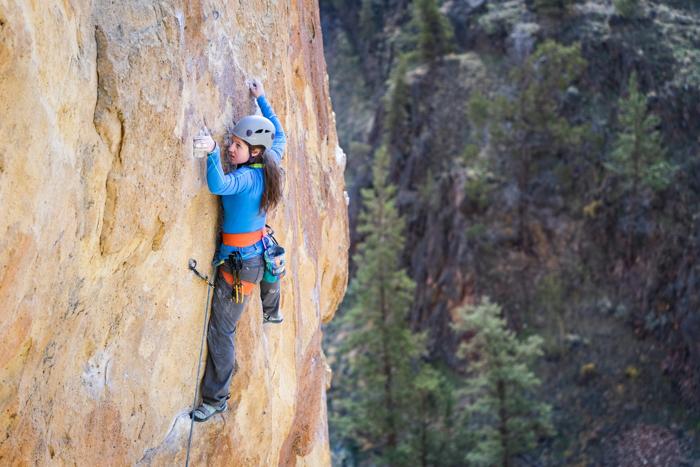
History of Sport Climbing
Smith Rock in the Oregon State Park is the birthplace of sport climbing in the United States, thanks to Allan Watts and his crew. They systematically bolted the routes on rappel and performed top roping moves before freeing them. While this may be the norm nowadays, it was a highly criticized practice back then.
In 1986, the famous French climber Jean-Baptiste Tribout helped cement the status of sport climbing. Climbing gyms absorbed the concept of sport climbing during the late 1980s, and both gyms and sport climbing became extremely popular during the 1990s.
Sport Climbing Preparation
Sport climbing, like any rock climbing, requires preparation. Although some may merely dismiss it like any other form of rock climbing, the nuances and technicalities in this sport can be pretty surprising. Hence, it’s crucial for any individual who wants to immerse in the world of sport climbing to find an experienced mentor.
Chances are, you already know who this person might be. After all, anyone who desires to try sport climbing has already tried indoor or gym climbing. It’s crucial to familiarize yourself first with the basics of gear handling and safety precautions before venturing into sport climbing.
A sport climbing mentor will teach you to lead climbing, rappelling, lead belaying, cleaning anchors, and hanging quickdraws at a minimum. If you’re lucky enough, they will teach you some “secrets,” which you should take close to heart.
Sport Climbing Grades
Route grading systems differ by country. However, the two most common come from France and the United States.
The French grading system is widely used in Europe. The difficulty increases with the rise of numbers (1 to 9), letters (a to c), and the plus sign symbol (6a+, 6b+, 7a+, 7b+).
The United States of America uses the Yosemite Decimal System, which runs from 5.0 to 5.15d (the latest). Unfortunately, the grades aren’t always consistent, even with the decimal system in the US. Typically, grades are approximately uniform in one area but radically differ between various areas. For instance, a 5.9 at Rifle may drastically go against the 5.9 of New River Gorge.
Also, it may surprise you that outdoor grades do not match the grades used in the gym. You will experience entirely different grading conventions in outdoor climbing, in this case, sport climbing. Remember that grading can be less formulaic and controlled in outdoor climbing, which makes outdoor climbs more challenging at a specified grade.
Sport Climbing Etiquette
While gyms may have their respective set of written rules, outdoors have their unspoken ones. There are two essential things you must adhere to when doing sport climbing: RESPONSIBLE STEWARDSHIP and FELLOWSHIP. These two are the backbone of silent rules in outdoor climbing.
Do not:
- Break local or wilderness ethics, restrictions, closures, or waivers. Respect the environment where you do outdoor climbing since your future access depends on your behavior.
- Leave garbage anywhere. It’s the basics and a sign of respect to both the environment and your fellow climbers. Do not leave food wrappers, tape shreds, or human waste on the site.
- Be too loud. Shouting, laughing out loud, and playing loud music can distract other climbers. Be mindful and considerate of them.
- Let your pet spoil the fun for others. Crag dogs, if poorly behaved, can be a source of stress and headache to other climbers. Make sure that your dog is well-behaved before bringing it to the crags.
- Top rope on any fixed hardware. Conventions vary in different areas, but this one is a big “NO!” The hardware is there for cleaning and not facilitating your top-rope moves.
- Take quickdraws or fixed hardware because it’s plain stealing. Feel free to use a hanging quickdraw if somebody left it. What you are not allowed to do is to take it as your own.
- Discard a gear or rope on a route you are not climbing.
Do:
- Organize your things. Try to contain your items as much as you can.
- Be kind and patient. Crags are places to enjoy and learn more about your interest. It would be best to keep it a warm place where happiness is shared. Do not embarrass or isolate other climbers, especially those who are pretty new to the sport.
- Wipe off markings. Don’t just leave them there; erase the markings you make when you’re done.
- Be friendly and communicative. Be transparent and open about your intentions, which will encourage everyone to do the same. You can also share information, the wall, or gear to show your goodwill.
Speed Climbing
As the name suggests, speed climbing is a form of indoor rock climbing with speed as the climber’s ultimate goal. It is also known as a discipline of competitive climbing that an individual or a team can do.
Climbers use their hands and feet for grip, pulling themselves up with straight arms. This method enables them to achieve their maximum speed as they move upwards or downwards while never losing momentum.
Speed climbing can be traced back to its origins in Soviet Russia in the 1940s, wherein the climbers’ scores are measured by the time it took them to complete the routes. Competition between two parties was quite common among Soviet climbers back then. In 1976, the Soviets introduced the first-ever international speed climbing competition in the Russian city of Gagra.
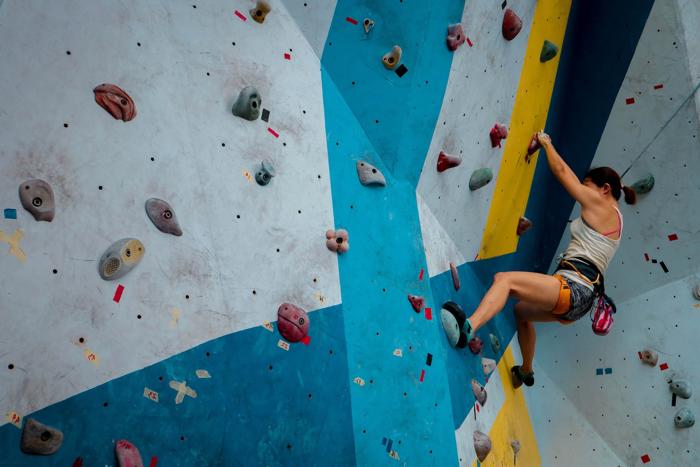
Meanwhile, modern speed climbing is a head-to-head battle for the fastest time on a fifteen-meter climbing wall with identically designed vertical routes. Speed climbers spend years mastering the discipline that can diminish fractions of a second of their time.
Since speed climbers rely on pulling their weight up with their arms, they must undergo special training for developing their upper body. It likewise provides them the advantage over other competitors who may have more developed upper body muscles than they have.
Those who want to stay physically fit and enjoy an adventure’s thrill can try speed climbing. It’s also a perfect activity for anyone looking to challenge themselves or overcome their fear of heights.
Traditional Climbing
Traditional climbing, also known as trad climbing, is the oldest type of competitive climbing. It emerged as a separate discipline from sport climbing in the 1980s. Compared to sport climbing which focuses on physical challenges, traditional climbing commands physical and mental prowess.
Traditional climbing requires carrying and placing protection such as climbing cams, chocks, and other devices instead of clipping protection into pre-assembled bolts. Traditional climbers must also have adequate technical knowledge of climbing anchors and the skill of creating them.
Traditional climbing is often done outdoors on natural climbing rocks where there are no pre-placed bolts.
Regarding grading, the United States uses the Yosemite Decimal System. Meanwhile, the United Kingdom has its dedicated traditional grading system called, The British Trad Grading System, divided into two parts—the adjectival and technical grades.
The adjectival grade, marked from Diff to E10, provides an overall picture of the route. It includes how sustained, protected, and difficult the course is.
The technical grade, marked from 4a to 7b, pertains to the difficulty of the most challenging single move performed on a route.
History of Traditional Climbing
The earliest known climbing forms as a sport are still under debate as no evidence shows that climbing was considered a sport. By the end of the 1800s and the dawn of the 1900s, people started rock climbing for fun, not solely for survival. Places such as the Elbe area in Germany, the Dolomites in Italy, and England became favorites of climbers. During the following decades, climbing strictly went up the rock face using equipment and placing bolts en route for protection.
As climbing developed into a sport around the 1970s and 1980s, rock climbing has expanded to several disciplines. Traditional climbing became a distinguished form of rock climbing in the 1980s due to some climbers identifying as more formal.
Trad climbing retained its core despite the constant innovation of protective gear and equipment. It is most prevalent in the United States, where larger rocks are formed. For instance, Utah and Yosemite have been dubbed traditional climbing meccas.
Getting Started
Before taking off to the rocks and hills with your climbing devices, you must know how they work— that’s given. You also must find a seasoned climbing instructor, make solid anchors, and place protection.
Before climbing the cliff, you must spend time on the ground and assess the necessary aspects. Consider fitting the cams, hexes, and wedges into varying rock features.
Different rock formations call for other gear pieces employed in various methods. Because of this, you have to gain confidence in your equipment and broad knowledge about them.
Types of Traditional Climbing
As mentioned above, traditional climbing has evolved, and some groups of climbers realize the differences in their form from that of other fellow trad climbers.
Below are some samples of still-valid forms of traditional climbing:
Big Wall Climbing
As the name suggests, this form requires climbers to climb a massive wall. Many consider big wall climbing as the most challenging yet exciting form of traditional climbing. How? First, the climber might be forced to use their equipment since there is an excellent chance that the entire route is not bolted. Secondly, this might mean that the climber would be climbing a collective of pitches, most likely over a couple of days. Since we’re talking about an actual traditional climber here, they would have to survive for the entire time without rappelling down for supplies (i.e., gear, water, and food) and ascending again afterward. Moreover, they should never leave anything behind, specifically trash and refuse, on the wall.
Bolted Climbing
Generally, trad climbing is unbolted, and all protection is placed on lead, although its earlier forms involved the climbers bolting the route as they go. Some traditional courses, particularly the older ones, already have bolts on. It’s up to climbers whether they use those bolts or opt to use something else.
Some people don’t consider bolted climbing as another form of traditional climbing. Some even argue that using pre-placed bolts is cheating. However, since these preset bolts are scarce and infrequent, many still believe that bolted climbing is another type of trad climbing.
Crack Climbing
Crack climbing is getting more popular in the US, and many consider it the “ultimate fighting with a rock.”
Crack climbing is typically unbolted; thus, climbers must put the gear on the lead to protect themselves in the process. By, crack climbing makes it yet another form of traditional climbing.
Bouldering
Many consider Bouldering the simplest form of climbing as it only requires chalk, a pair of climbing shoes, and crash pads. It is practiced on indoor walls, small rocks, boulders, or artificial exterior bouldering walls. Ropes are unnecessary for this activity since the climbers don’t need to climb very high and jump back down.
History of Bouldering
No one can point out where Bouldering originated, but many believe it started in the Lake District, United Kingdom, and Fontainebleau, France. These two areas are abundant in sandstone boulders sitting in the middle of the forests and were the grounds where the term BLEAUSARDS or more popularly known as “boulderers.”
Bouldering got two new forms of training tools in the 1980s. First, the climbing gyms and indoor Bouldering helped develop the sport in artificial settings. It also enables boulderers to train constantly regardless of the weather, climate, or season. The second is called CRASH PADS or BOULDERING MATS. This tool helps absorb the shock during the climber’s fall, protecting them from bad falls and injuries. Boulderers can also venture to new climbing routes and previously deemed high-risk terrains.
Bouldering is still growing in popularity worldwide, particularly in Europe and the United States. Since many people have shifted their interest in Bouldering, it’s only reasonable to establish a system that aids climbers in identifying the difficulty of a boulder problem before trying them. Two primary grading scales are in use today, the FONT SCALE and the V SCALE. The first is widely used in Europe while the latter is popular in North America.
John Gill, an American mathematician, devised the Font Scale (short for FONTAINEBLEAU SCALE), which uses an open-ended numerical system, ranging from 1 to 9A.
The second one, John “Verm” Sherman’s V SCALE (also known as the HUECO SCALE Was developed in the 90s at Hueco Tanks State Historic Site. The difficulty ranges from V0 to V17, although the system is open-ended. VB is sometimes used for problems easier than V0. Sometimes, issues are post-fixed with + (for more difficult ones) or – (for easier ones) to determine the difficulty range within a single grade.
Reasons to Try Bouldering
Bouldering presents several benefits for your general well-being, and these include:
Physical and Mental Improvement
Bouldering does not merely guarantee a full-body workout but also mental exercises. It requires the mobilization of your entire body — not merely your arms or upper body — to complete the route.
Bouldering helps boost core strength, balance, and flexibility. In the beginning, you might not feel the difference, but you will get the after-effects gradually from your shoulders, abs, and lower limbs. Aside from these, your finger grip will immensely get stronger.
With Bouldering, your brain also has the opportunity for a workout. It improves your focus as you complete each challenge along the route you take, and you will realize it leaves no space for distractions or idle thoughts. Moreover, Bouldering allows you to dispense stress as you burn off calories, leaving you refreshed and reinvigorated by the end of the day.
Interconnection With People
Bouldering is a community sport as you have to work with other boulderers to figure out routes together. You also gain the opportunity to meet other people from different backgrounds and statuses in life. This setting differs from the likes of rope climbing, wherein climbers are spread out across separate lanes. In Bouldering, you have to give and take since some routes extend over others. You can exchange ideas and tips with fellow boulderers when this happens.
Bouldering aids in breaking down boundaries as you can start a conversation or interaction without feeling awkward. Instead, you almost instantly share a feeling of camaraderie because of your common interest and hobby.

